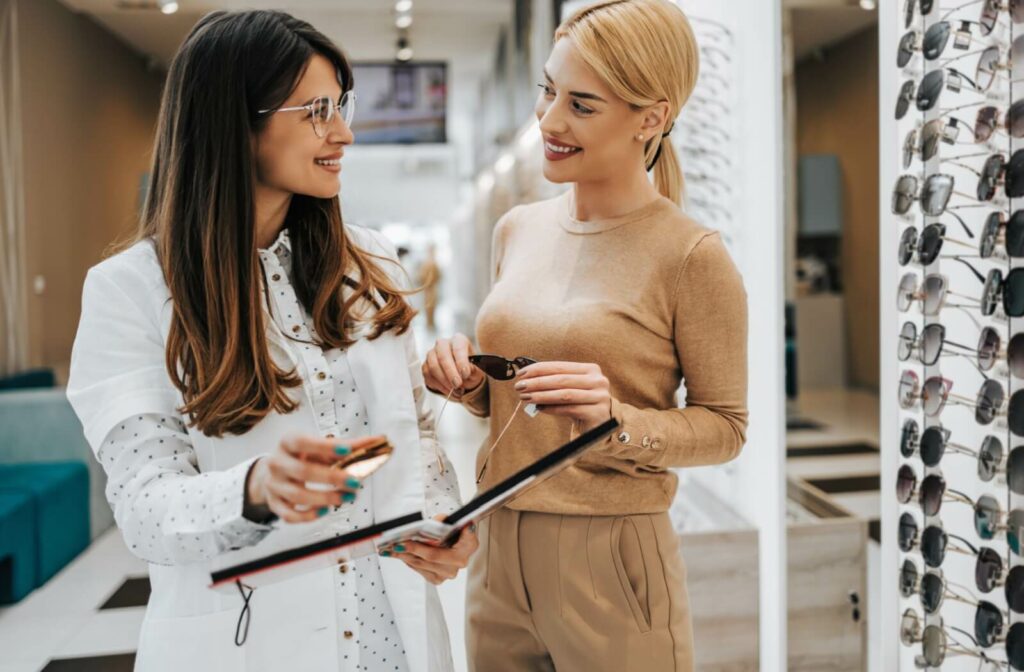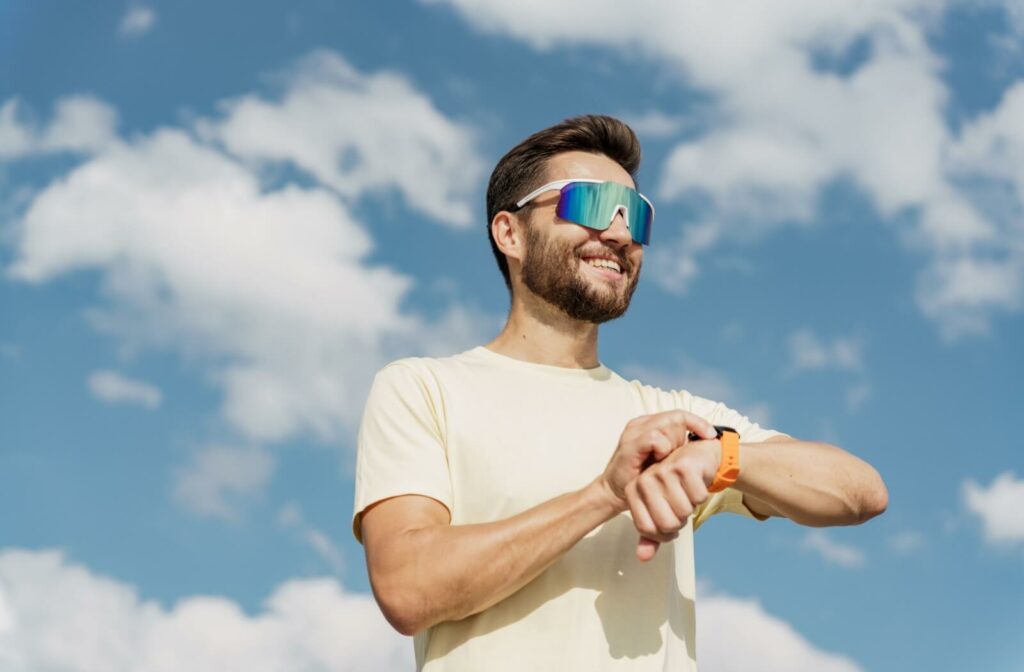As we transition to warmer months, we spend more time basking in the sun. However, although the benefits of sunlight are great for mental health, the sun’s ultraviolet rays can do more harm than good without protection.
Just as sunscreen protects our skin, sunglasses with UV protection offer similar benefits, reducing our risk of developing serious eye concerns that can harm your vision.
Invest in sunglasses with “100% UV protection” or “UV4000 protection”. These labels indicate that the lenses effectively block UV rays.
With so many factors to keep in mind, purchasing your sunglasses from your optometrist helps keep things simple.
How UV Light Affects Your Eyes
Ultraviolet (UV) light is a type of electromagnetic radiation emitted by the sun. It occupies a space below the visible spectrum, making it invisible to the naked eye.
There are 3 categories of UV light rays:
- UVA Rays: These rays penetrate deeply into the skin and cause premature aging. Similarly, they can affect the deep layers of your eyes. UVA makes up about 95% of the UV radiation we experience.
- UVB Rays: Although these rays are instrumental in Vitamin D production, they’re the prime cause of sunburns and a contributing factor in the formation of melanomas. These rays are also extremely damaging to the eye’s outer structures. About 5% of the radiation we experience is from UVB rays.
- UVC Rays: The earth’s atmosphere typically blocks these rays, so they are generally of no concern.
Prolonged exposure to UV light can seriously harm your eyes. Unlike sun damage to the skin, the effects of UV damage on the eyes often go unnoticed initially.
The following eye concerns may result from too much UV exposure:
- Corneal Damage (Photokeratitis): Also known as a sunburn of the cornea, photokeratitis develops from both direct or indirect (reflected) UV exposure, causing painful sunburn-like symptoms on the cornea, including redness, blurry vision, and irritation.
- Cataracts: UV exposure accelerates cataract formation, a condition that clouds the eye’s natural lens, causing blurry, foggy, or hazy vision. Cataracts can be treated with surgery.
- Macular Degeneration: UVA rays can damage the retina, particularly the macula, which is responsible for sharp, central vision.
- Pinguecula and Pterygium: A growth on the white part of the eye that can extend onto the cornea. This can be uncomfortable, unsightly, and can even interfere with vision.
- Skin Cancer Around the Eyes: The delicate skin around the eyes is particularly susceptible to UV-induced skin cancers such as melanoma.
Routine eye exams can detect these concerns early, allowing for earlier intervention. However, preventative measures can reduce the risk of these concerns.
The Role of Sunglasses in UV Protection
Sunglasses are more than just a fashionable summer staple. They act as a physical shield for your eyes, protecting them from the sun’s harmful rays.
Along with improving visibility and reducing glare, the benefits of sunglasses include:
- UV Protection: UV-blocking sunglasses filter 99% to 100% of UVA and UVB rays.
- Comfort and Safety: They enhance visibility and reduce glare, making outdoor activities safer and more enjoyable.
Sun protection isn’t restricted to the warmer months, however. It’s also important in winter, even though the sun feels less intense.
That’s because UV rays are present year-round. Snow can act as a reflective surface, amplifying the effects of UV exposure by bouncing UV light back into your eyes.
Wearing quality sunglasses protects your vision from these risks year-round, even when the skies are cloudy and gray.

What to Look for in Sunglasses
With that said, not all sunglasses are the same.
Buying over-the-counter sunglasses is easy and convenient, but just because glasses have a dark tint doesn’t necessarily mean that they’re protecting your eyes.
Here’s what to prioritize when shopping for a new pair:
- UV Protection Label: Look for sunglasses labeled as “100% UV protection” or UV400 protection.
- Wraparound Design: Wraparound sunglasses provide side coverage so that UV light doesn’t reach your eyes around the frames.
- Polarized Lenses: Although polarization is separate from UV protection, it reduces glare and enhances comfort, especially near water or snow. If you spend a lot of time driving or outdoors, consider investing in polarized sunglasses with UV protection.
- Durable Materials: Over-the-counter sunglasses are made from low-grade materials that aren’t built to last. The quality and material of your sunglasses can make a real difference.
Preventing UV Damage Beyond Sunglasses
Although wearing UV protection sunglasses is effective in protecting your eyes from UV damage, combining them with other preventative measures further reduces risks:
Go Beyond Sunglasses
Pair your sunglasses with a wide-brimmed hat to reduce sun exposure to your face and eyes.
Studies show that large-brimmed hats can block up to 50% more UV rays when worn alongside sunglasses.
Use UV Blocking Contact Lenses
If you wear contact lenses, consider upgrading to lenses with built-in UV protection. While they do not replace sunglasses, these lenses do provide an added layer of defense.
Adopt a Mediterranean Diet
Nutrition plays a key role in eye health.
A Mediterranean diet rich in fruits, vegetables, omega-3 fatty acids, and antioxidants (like those in leafy greens and fish) can combat oxidative damage caused by UV exposure and support eye function.
Stay Mindful Indoors & Near Windows
UV rays can penetrate glass windows, exposing you to UV light indoors or while driving. Opt for window films or UV-blocking glass coatings to limit indoor exposure.
Small Changes, Lifelong Benefits
Taking steps to shield your eyes from UV damage is an investment in your long-term vision.
From choosing the right sunglasses to adopting a UV-conscious lifestyle, every action helps. UV protection isn’t just a precaution; it’s an essential part of modern eye care.
If you’d like personalized advice on protecting your eyes or need help selecting your sunglasses, Cherry Creek Eye Physicians & Surgeons is here to support you.


